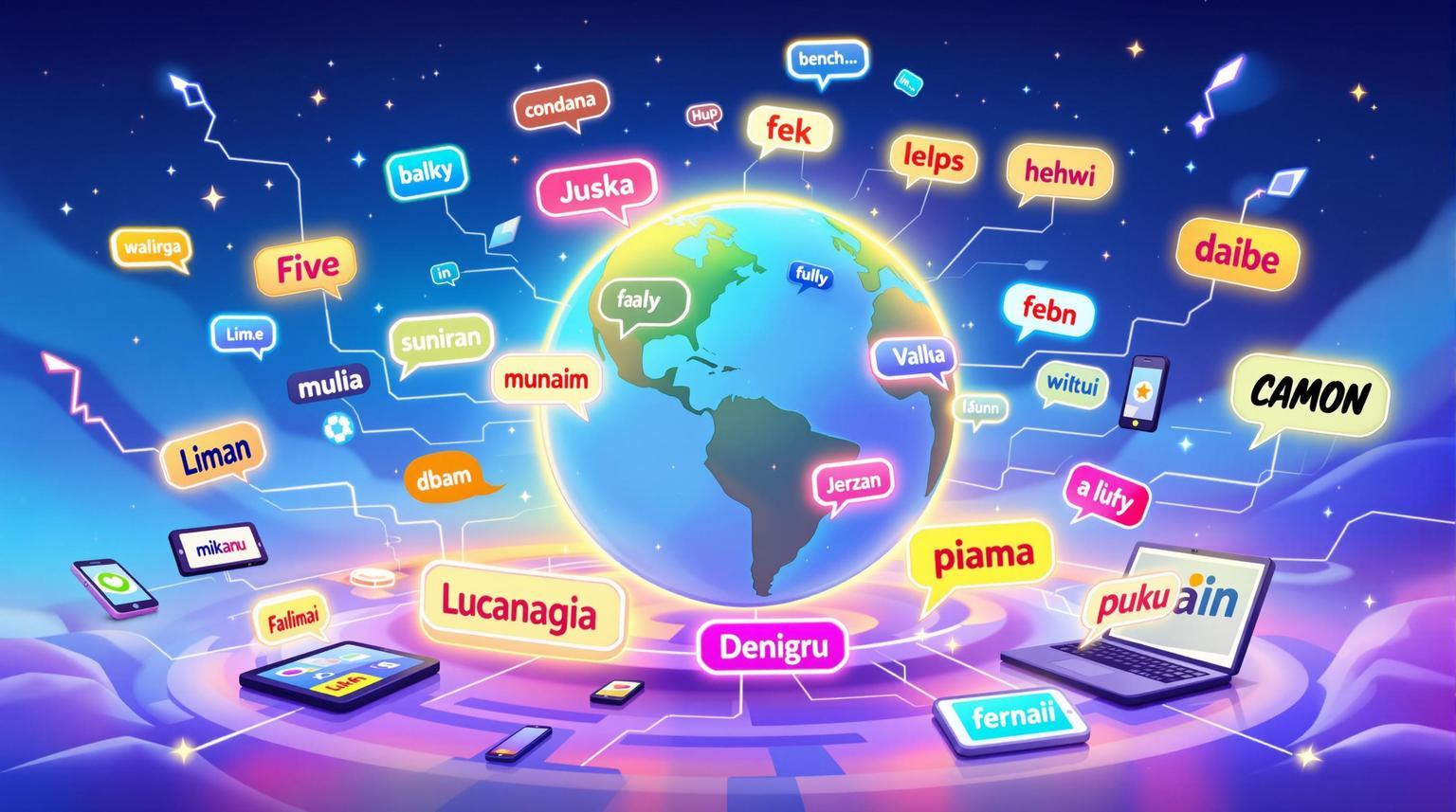
LongStories is constantly evolving as it finds its product-market fit. Features, pricing, and offerings are continuously being refined and updated. The information in this blog post reflects our understanding at the time of writing. Please always check LongStories.ai for the latest information about our products, features, and pricing, or contact us directly for the most current details.
How AI Delivers Multilingual Content Across Devices
AI is transforming how multilingual content is created and shared, making it faster, more accurate, and accessible across devices. Here's what you need to know:
- Why It Matters: 72.1% of people prefer content in their native language, and multilingual companies see 35% more revenue. In education, children learn better when materials reflect their language and culture.
- Challenges: Traditional methods are costly, slow, and inconsistent. For example, manual translation can cost $25/hour and take months to complete.
- AI Solutions: AI tools automate translation, ensure quality, and adapt content for different devices. They cut costs by up to 80% and speed up production from months to hours.
- Impact on Education: Platforms like LongStories.ai create personalized, multilingual stories for kids in under a minute. Video content, available in native languages, improves retention by 75%.
- Business Benefits: AI-powered localization boosts conversion rates by 20% and saves businesses billions annually by 2030.
The future of multilingual content is efficient, fast, and personalized - thanks to AI.
How Mercedes-Benz is Revolutionising Global Learning with AI-Driven Content Delivery

How AI Creates and Delivers Multilingual Content
AI is reshaping the way educational content is shared globally by analyzing context, addressing cultural subtleties, and producing engaging multimedia materials.
AI Translation and Localization Tools
Today's AI technologies, powered by Neural Machine Translation (NMT) and Natural Language Processing (NLP), deliver translations that go beyond word-for-word accuracy. They analyze entire sentences and paragraphs to ensure the tone, meaning, and context are preserved. This level of precision helps content resonate with audiences in different regions.
The impact of AI-assisted translation is clear: localized landing pages and ads can boost conversion rates by 20%, while efficiency in translation processes can increase by up to 50% without compromising quality. For context, traditional translation services in the U.S. typically charge around $0.22 per word.
Joaquín Muñoz, Localization Manager at Life360, highlights the advantages:
"With AI we cut time in less than half and costs by 80%, so big savings in time and money with the same output at the end."
AI achieves this by combining machine learning, translation memories, and cultural data to create content that feels authentic to local audiences. Translation memories, for instance, store previously translated phrases, helping AI maintain consistency across projects while learning from human input.
However, cultural accuracy is just as crucial as linguistic accuracy. A survey found that 86% of native speakers have encountered culturally inappropriate translations, and 62.4% believe cultural nuances are often overlooked during the process. To address this, AI systems integrate databases that account for local values, beliefs, and social norms, ensuring translations align with the target audience's expectations.
This focus on precision extends seamlessly to multimedia content creation.
AI-Generated Multimedia Content Creation
AI takes localization further by transforming simple text prompts into fully localized videos, voiceovers, and animations. Using text-to-video algorithms and NLP, it ensures consistency across devices and languages.
The demand for this technology is immense. More than three billion internet users watch videos regularly, and 76% of online shoppers prefer content in their native language. This opens up vast opportunities for platforms that can deliver personalized, multilingual video content efficiently.
AI video generation is a multi-step process. It starts by analyzing scripts, then moves on to creating visuals, generating voiceovers in multiple languages, and synchronizing everything into a polished final product. This approach eliminates the need for separate translators, voice-over artists, and video editors for each language, significantly reducing costs while speeding up production.
A great example is LongStories.ai, a platform that lets parents and teachers create personalized animated stories where children become the main characters. From a single text prompt, the system generates scripts, illustrations, voices, and timing, producing shareable HD videos in under a minute. Since its debut, it has created over 5,000 video adventures.
Modern AI video tools also offer features like automated editing, scene selection, multilingual voiceovers, and real-time subtitle creation. These systems can translate scripts, create localized versions, and add subtitles or dubbing with natural-sounding AI-generated voices, making multilingual video production faster and more accessible than ever.
Quality Control Through AI and Human Teams
The best results come from blending AI's efficiency with human expertise. While AI excels at handling large volumes of data and repetitive tasks, human professionals refine the output to ensure it connects with the intended audience.
This collaboration is supported by structured quality assurance processes. AI-powered quality estimation (AQE) tools, for example, evaluate translations for accuracy and flag errors for human review. This allows linguists to concentrate on the most important details.
Matt Rodano, VP of Account Management at Acclaro, describes their approach:
"At Acclaro, we recognize the transformative potential of AI in localization, but we keenly understand its limitations. Our approach is to help our clients implement AI where it truly adds value and maintain human expertise to control accuracy, maintain brand voice, and deliver culturally nuanced content that their customers expect."
By automating routine tasks, AI frees up time and resources for creative and culturally sensitive elements of content creation. This is especially important in fields like legal, technical, or medical translations, where accuracy is paramount. Similarly, educational content for children requires careful attention to ensure it uses age-appropriate language, respects cultural norms, and remains engaging.
Quality control processes often include regular audits, feedback from language experts, and continuous monitoring of AI outputs. Teams also develop ethical guidelines to address issues like cultural sensitivity, data security, and transparency.
Setting Up Multilingual AI Workflows Across Devices
Creating effective multilingual AI workflows requires thoughtful planning and a solid technical foundation. With AI improving translation accuracy and multimedia production, having efficient workflows ensures smooth content delivery across various devices.
Automating Content Localization
The foundation of a successful workflow lies in well-structured content. By organizing content as data, you enable scalable AI translation. Start by standardizing metadata and formatting right from the beginning.
Set up parsing rules early to identify different file types and protect non-translatable elements like code or brand names. Quick test ingestions can help spot potential issues, while a pseudo translation step can catch layout errors or hardcoded text before full deployment. Use your Translation Management System's term harvesting tools to maintain consistent terminology across all translations.
Modern workflows typically include steps like content ingestion, AI pre-processing, translation, human post-editing, quality checks, and continuous delivery. To streamline this process, configure engine profiles and set up rules to automatically select the best machine translation engine based on your content's metadata.
For example, Mouser Electronics partnered with Welocalize to implement an AI-powered solution for multilingual campaigns. This approach streamlined their translation processes, reduced time to market, and maintained high-quality standards. This case highlights how AI-integrated workflows can speed up multilingual content delivery while ensuring consistency.
Maintaining Consistency and Compliance
Once automated localization is in place, the next step is ensuring consistency and adhering to regulations. This balance of AI efficiency with human oversight helps maintain your brand's voice and cultural accuracy. Develop a detailed style guide covering grammar, tone, formatting, and key terminology. Reuse approved translations through Translation Memories to keep content accurate.
Automated quality assurance tools can flag issues like number mismatches, missing glossary terms, or inconsistent formatting, helping maintain high standards at scale. Ensure your workflows comply with regional privacy regulations like GDPR and HIPAA. Rigorous localization testing - covering linguistic accuracy, user interface adjustments, legal compliance, and cultural nuances - is essential. Companies that personalize localized content have reported conversion rate increases of 10–15%.
Real-Time Updates and Synchronization
With structured localization and consistency in place, modern workflows need to handle seamless real-time updates across devices. Integrating your Translation Management System with your codebase allows for instant localization, minimizing delays and ensuring updates reach all platforms simultaneously. Automating content flow using webhooks or branch triggers further streamlines the process from staging to production.
AI tools now support real-time dubbing and subtitling for live content. For instance, SyncWords can translate content from over 50 source languages into more than 100 target languages instantly, using translation glossaries and ASR dictionaries for accuracy. To ensure effective delivery, your system should support key video streaming protocols like HLS, RTMP(S), and SRT. Multilingual content management systems and APIs simplify tracking, updating, and publishing content across languages.
A practical example of real-time synchronization is seen with LongStories.ai, a platform for educational content. Their system generates personalized stories that become instantly accessible across devices, ensuring children can enjoy their content on a tablet at home or a computer at school. This showcases how real-time updates can enhance user experiences across platforms.
sbb-itb-94859ad
Improving User Experience Through Personalization
Building on the foundation of multilingual workflows, AI takes user experience to the next level by personalizing educational content. It adapts lessons to match each child's learning style, language, and background. This tailored approach boosts engagement and enhances learning outcomes. By combining personalization with efficient cross-device localization, AI ensures smooth and effective learning experiences.
Child-Focused Storytelling with AI
When children become the heroes of their own stories, the emotional connection to the content deepens. AI can craft personalized narratives that align with a child’s interests, learning level, and cultural background, all while supporting multiple languages. Studies reveal that deep personalization through AI improves language proficiency by 48.53% compared to traditional methods.
Take LongStories.ai as an example. This platform creates personalized animated stories where children are the protagonists. Since its launch, it has delivered over 5,000 unique video adventures. Parents or teachers simply input a text prompt, and the system generates a complete story - complete with script, illustrations, voices, and timing. AI also analyzes the child’s responses, offering real-time feedback to keep them engaged and learning.
Local Language and Custom Personalization
AI doesn’t just translate content - it adapts it to fit local languages, customs, and cultural nuances, creating meaningful and relatable learning experiences. Research shows students learning in their native language are 60% more likely to achieve reading goals. For instance, tools like MIT's "Lingua" improve conversational fluency by over 40% within months, while EduLingua reports an 85% increase in language acquisition for emergent bilingual students.
Modern AI systems go further by assessing pronunciation, fluency, and intonation in multiple languages. They provide instant feedback, helping students refine their skills. These tools also create personalized learning paths tailored to a student's proficiency and preferences. Educators can use AI to develop bilingual materials, quizzes, and presentations that work seamlessly across devices, all while incorporating diverse cultural perspectives to keep students engaged and successful.
Balancing Fun with Educational Value
Blending engaging content with personalized feedback makes learning both effective and enjoyable. AI systems designed with clear educational goals and age-appropriate guidelines ensure a balance between fun and learning. For example, AI-driven feedback can enhance writing skills by 71% and reduce content creation time by up to 70%, allowing educators to focus on crafting meaningful lessons.
AI-powered voices in educational apps provide real-time guidance, accurate pronunciation in multiple languages, and interactive conversations. They enrich storytelling by offering a variety of voices and emotional tones while maintaining a strong educational focus. By tracking progress and delivering immediate feedback, AI keeps students and teachers on the same page, ensuring effective learning across languages and cultural contexts.
Conclusion: The Future of Multilingual Content Delivery with AI
AI is redefining how multilingual educational content is delivered, marking a major leap forward in personalized learning. Organizations utilizing AI-driven systems have reported a 32% boost in content delivery efficiency across various regions and a 47% increase in engagement rates for their multilingual content - clear evidence of its impact on reaching diverse audiences.
These systems are also speeding up processes, cutting content processing time by 45%, while achieving a remarkable 78% success rate in capturing cultural nuances - far surpassing the 45% rate seen with traditional methods. This ensures that content not only translates but also resonates with learners from different cultural backgrounds.
Still, it's important to take a balanced approach.
"AI is a tool, not a silver bullet." - Renato Beninatto, Nimdzi
This quote underscores the importance of pairing AI's capabilities with human expertise. While AI excels at automating repetitive tasks, analyzing learning behaviors, and adapting content in real time, human educators remain vital. They provide emotional support, foster relationships, and ensure the content aligns with broader educational goals.
Looking ahead, AI-driven translation tools are projected to save businesses $15 billion annually by 2030, reducing reliance on human translators for routine tasks. For education, this means more accessible and affordable multilingual learning materials. Learners using AI tools are already acquiring languages 25% faster than through traditional methods, while businesses using AI for training report a 35% improvement in language proficiency within just six months. These numbers highlight the transformative potential of AI in personalized, multilingual education.
Platforms like LongStories.ai are already paving the way. With over 5,000 video-based learning adventures created since its debut, this platform exemplifies how AI can craft personalized, culturally aware content that adapts to individual needs, all while maintaining educational quality across multiple languages and devices.
The path forward combines automation, personalization, and cultural sensitivity. As AI continues to improve its understanding of context, emotion, and cultural subtleties, it promises to create learning experiences that go beyond translation to truly connect with each learner on a local level. This is the future of multilingual education.
FAQs
How does AI maintain cultural accuracy and sensitivity when translating content into multiple languages?
AI plays a key role in ensuring translations are aligned with the cultural norms and values of a target audience. It does this by analyzing the context, adjusting references to fit cultural expectations, and carefully choosing words or phrases that make sense within the cultural framework. Advanced algorithms help flag potential issues, such as idioms or expressions that might not work well across different cultures.
That said, AI isn't perfect. It can sometimes miss subtle cultural cues or fail to fully capture emotional undertones. This is where human expertise becomes crucial. Translators or editors can step in to fine-tune the output, ensuring it resonates with the intended audience on a deeper level. By combining the speed and efficiency of AI with the insight and sensitivity of human oversight, the translation process becomes far more accurate and culturally aware.
What are the main benefits of using AI for translating multilingual content?
AI brings several standout advantages to translating multilingual content. For starters, it offers lightning-fast translation speeds, handles large amounts of text with ease, and cuts costs thanks to automation. These strengths make it an excellent choice for businesses tackling tight deadlines or managing high-demand projects.
On top of that, AI-powered tools are highly scalable and, when combined with translation memory tools, can deliver impressive accuracy that rivals human translators. While it may occasionally struggle with subtle cultural nuances, AI’s ability to produce consistent, high-quality translations allows businesses to expand globally and deliver localized content across platforms quickly and efficiently.
How can AI enhance multilingual learning for children across different cultures?
AI-powered tools transform learning for children by offering customized multilingual content that aligns with their language and cultural background. These tools can translate and adapt educational materials instantly, making it easier for kids to grasp concepts in their native language.
Beyond translation, these systems integrate culturally relevant examples, visuals, and interactive features, creating a more meaningful connection with the material. By addressing language challenges and accommodating various learning styles, AI encourages inclusive education and ensures smooth learning experiences across different devices, delivering a more engaging and enriching journey for kids worldwide.
